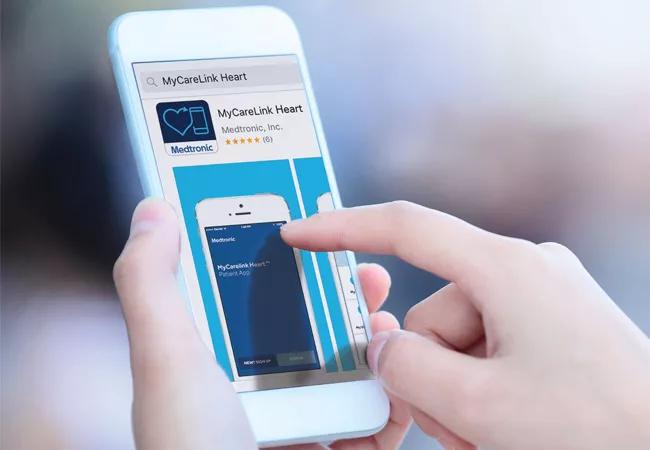Results of BlueSync Field Evaluation may reshape remote monitoring

Empowering patients with implanted cardiac pacemakers to use a smart device app for remote monitoring resulted in a significantly higher rate of scheduled transmission success compared with traditional manual and automatic bedside monitoring technologies, report investigators with the international BlueSync Field Evaluation. They also found a comparable rate of transmission success among patients using the new technology outside the study, suggesting a similar experience in real-world use.
Advertisement
Cleveland Clinic is a non-profit academic medical center. Advertising on our site helps support our mission. We do not endorse non-Cleveland Clinic products or services. Policy
“There is abundant evidence that remote monitoring of pacemakers can improve patient outcomes, but patient adoption of and adherence to remote monitoring has remained suboptimal,” says the study’s principal investigator, Khaldoun Tarakji, MD, MPH, who presented the findings virtually this week as a late-breaking clinical trial during the Annual Scientific Sessions of the Heart Rhythm Society.
“This study is the first large assessment of the use of smartphones or tablets for direct monitoring of pacemakers,” says Dr. Tarakji, Associate Section Head of Cardiac Electrophysiology at Cleveland Clinic. “Its encouraging findings have the potential to reshape monitoring of patients with pacemakers and other cardiac implantable electronic devices.”
The BlueSync Field Evaluation takes its name from Medtronic’s BlueSync® technology, which employs low-energy Bluetooth® wireless telemetry to allow patients to use their own smart device, whether a smartphone or a tablet, to directly monitor their new-generation pacemaker or biventricular pacemaker (including cardiac resynchronization therapy [CRT] pacemakers). Patients do so by leveraging an app-based platform, the MyCareLink Heart™ App, that can transfer pacemaker data to patient management networks, such as CareLink™, without use of a traditional bedside monitor. End-to-end encryption keeps the pacemaker data secure.
“The app allows patients to use their smartphone or tablet as their transmitter,” Dr. Tarakji explains. He adds that it also represents the first time that patients are given direct access to some of their pacemaker data, including information about their implanted device, activity tracker data and transmission history.
Advertisement
The Medtronic-sponsored investigation was a prospective, multicenter evaluation of patients with bradycardia from the U.S., France, Italy and the United Kingdom. All had a BlueSync-compatible pacemaker or CRT pacemaker implanted either de novo or for device replacement.
Patients were enrolled from April through December 2018 using the MyCareLink Heart App and followed for 12 months. To be included in the analysis, patients needed to own a compatible smart device and be willing to use it during the study period. They also needed to have at least one scheduled data transmission between months 1 and 12 following enrollment.
Patients in the BlueSync group were compared with three historical real-world control groups who were activated in the CareLink patient management network at some point in 2016-2018 and followed for at least one year. The control groups consisted of the following:
The primary endpoint was the success rate of scheduled data transmissions over 12-month follow-up.
In the BlueSync group, 245 patients were eligible for analysis; they had a mean age of 65 years and were predominantly (58%) male. Most (79%) had a pacemaker (nearly all dual-chamber devices), with 21% having a CRT pacemaker.
Advertisement
Over 12 months, these 245 BlueSync patients had a total of 953 scheduled transmissions, of which 902 were successfully completed, yielding a success rate of 94.6%.
After an algorithm was used to match the three control groups to the BlueSync group for age, sex and number of device chambers, the following scheduled transmission success rates were identified:
Each of these success rates was significantly lower than that in the BlueSync group (P < 0.001).
To get a sense of real-world use of the BlueSync technology, the researchers also tracked scheduled transmission success for 811 patients using the MyCareLink Heart App for at least 12 months outside of the study. Among these patients (mean age, 69 years; 62% male), the success rate was 92.8%, highly consistent with the 94.6% rate in the formal BlueSync evaluation group.
“This study shows that long-term follow-up with BlueSync-compatible pacemakers using an app-based platform produces a higher rate of success in scheduled transmissions compared with traditional remote monitoring options,” Dr. Tarakji notes. “And the findings from our real-world assessment suggest that actual experience with this technology outside an investigative setting is similar what we observed in the study.”
He and his coinvestigators acknowledge that this evaluation is limited by its nonrandomized nature and the fact that not all factors influencing transmission success could be assessed.
Advertisement
Despite these limitations, the findings suggest a likely shift in remote monitoring and patient experience with cardiac implantable electronic devices in general, says Dr. Tarakji’s colleague, Oussama Wazni, MD, Section Head of Cardiac Electrophysiology at Cleveland Clinic. “Some patients find traditional remote monitoring technology daunting or unwieldy,” Dr. Wazni observes. “Even when traditional systems function properly, the transmission process remains invisible to the patient. When monitoring is done via smart devices, patients know more about their health status. That can be empowering as well as more convenient and reliable.”
Photo at top courtesy of Medtronic.
Advertisement
Advertisement

End-of-treatment VALOR-HCM analyses reassure on use in women, suggest disease-modifying potential

New Cleveland Clinic data challenge traditional size thresholds for surgical intervention

3 specialists share multidisciplinary perspectives on a widely impactful cardiovascular condition

Experience-based takes on valve-sparing root replacement from two expert surgeons

Two surgeons share insights on weighing considerations across the lifespan

Join us in Florida this winter for a long-standing CME favorite

BITA grafts themselves are rarely to blame, and outcomes can be good

First-in-human phase 1 trial induced loss of function in gene that codes for ANGPTL3